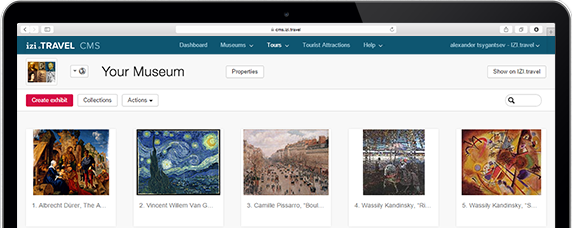Only in English
The Grand Kremlin Palace. The State Armory Collections
Update Required To play the media you will need to either update your browser to a recent version or update your Flash plugin.
The grandiose building with carved white stone decoration is the Grand Kremlin Palace.
The main facade of the Grand Kremlin Palace extends for 125 metres along the brow of the Borovitsky Hill. The windows might suggest a three-storey building, but in fact there are only two – there are State Rooms on the upper level, and the architect built them with a double set of windows. The building was always planned as the residence of Emperors – later the Supreme Soviet of the USSR made its residence there. More than 700 rooms add up to a staggering total of 20,000 sq.m of floorspace!
The palace has no fewer than five grand halls – the St.George Hall, the Vladimir Hall, the Alexander Hall, the Andrei Hall, and the Catherine Hall. The halls take their names from the medals of the Russian Empire. Currently they are used for state and diplomatic ceremonies and official receptions. The Palace is the official ceremonial residence of the Russian President. Presidential inaugural ceremonies take place in the palace.
If you had stood here in the C15th you would have seen an entirely different palace – the Palace of Tsar Ivan III. The palace was finally demolished in the C18th on orders of Empress Elizaveta Petrovna, Peter the Great's daughter, and a new palace built. However, just a century later Tsar Nikolas I decreed the palace unsuitable, and built another. Nevertheless the architects have managed to work elements of the C15th and C18th palaces into the present one. The Vladimirsky Hall provides the link between the old and new parts of the palace. The Grand Kremlin Palace links to several other important locations – the Granovitaya, or Faceted Palace, the Tsarina's Golden Chamber, and the Terem Palace. However, since the building is part of the Presidential Residence, access to all these areas is firmly closed to visitors.
The tower with the stepped pyramid appearance and gates is the Borovitskaya Tower. It stands atop the south-west slope of the Borovitskaya Hill, which is the main location of the Kremlin. To the left of the tower, behind the trees, you can see the Cathedral of Christ the Saviour in the distance. Turning to the right is Borovitskaya Street, and on it we see a three-storey light-coloured building – the State Armory Collection. It's formed in a similar style to the Grand Kremlin Palace. In the basement of this building there is the public exhibition of the State Diamond Fund Of Russia.
Don't be confused by the military name of the State Armory Collections – they are not about armour at all, and instead contain the Treasure Of The Tsars, including the magnificent collection of English Silver, the Royal Ceremonial Carriages, and the Fabergé Eggs. Entry is strictly by time-allocated ticket (your Kremlin ticket is not valid for this additional collection), and you would do well to purchase a ticket in the morning if you intend visiting in the afternoon – or ideally buy the day before (remembering that the Kremlin is closed on Thursdays). Tickets sell-out in advance, so don't miss your chance.
The State Armoury Collections are housed in a charming palace building richly decorated in the neo-Russian style. It was built especially for the collection in the mid-C19th by the architect Kontantin Ton – the same Ton, indeed, who build the Grand Kremlin Palace.
Even back in the C15th Ivan III ordered a stone treasure-house to be built near the Cathedral of the Annunciation called the Treasury Court, to which all the valuables of the Grand Treasury were transferred. They'd previously been hoarded away in church basements for safe keeping. Later there appeared the Royal Jeweler Workshops, the Tsars and Tsarina's Chambers and the Silver Collection. Once the Armory Collection was built, all royal treasures were transferred to it.
The State Armory Collections are one of the world's most famous treasure-houses. The Armory’s nine halls display over four thousand exhibits, some of which date back to the C4th. Firearms and tournament armor, gold and silver utensils, jeweler, court and ecclesiastical costume, and many other things are on display. Of especial interest are the Cap Of Monomakh (Russia's oldest royal crown); the gold crown, orb and sceptre of Mikhail Romanov; and the diamond headgear of Peter I. There are gold and silver jugs, goblets and gold altar-crosses adorned with precious stones. But for many western visitors the three greatest don't-miss highlights are the English Silver collection, considered the finest in the world; the Royal Ceremonial Carriages; and most of all the Fabergé Eggs.
The right-hand wing of the Armory Chambers building has a permanent display (for which a separate ticket must be purchased) – the State Diamond Fund of Russia. A large signboard announced the entrance.
The State Diamond Fund of Russia is one of the rare world collections which displays unique gems, jewelry, gold, platinum nuggets, and – of course – diamonds. The collection began to take shape even under Tsar Peter I.
The main facade of the Grand Kremlin Palace extends for 125 metres along the brow of the Borovitsky Hill. The windows might suggest a three-storey building, but in fact there are only two – there are State Rooms on the upper level, and the architect built them with a double set of windows. The building was always planned as the residence of Emperors – later the Supreme Soviet of the USSR made its residence there. More than 700 rooms add up to a staggering total of 20,000 sq.m of floorspace!
The palace has no fewer than five grand halls – the St.George Hall, the Vladimir Hall, the Alexander Hall, the Andrei Hall, and the Catherine Hall. The halls take their names from the medals of the Russian Empire. Currently they are used for state and diplomatic ceremonies and official receptions. The Palace is the official ceremonial residence of the Russian President. Presidential inaugural ceremonies take place in the palace.
If you had stood here in the C15th you would have seen an entirely different palace – the Palace of Tsar Ivan III. The palace was finally demolished in the C18th on orders of Empress Elizaveta Petrovna, Peter the Great's daughter, and a new palace built. However, just a century later Tsar Nikolas I decreed the palace unsuitable, and built another. Nevertheless the architects have managed to work elements of the C15th and C18th palaces into the present one. The Vladimirsky Hall provides the link between the old and new parts of the palace. The Grand Kremlin Palace links to several other important locations – the Granovitaya, or Faceted Palace, the Tsarina's Golden Chamber, and the Terem Palace. However, since the building is part of the Presidential Residence, access to all these areas is firmly closed to visitors.
The tower with the stepped pyramid appearance and gates is the Borovitskaya Tower. It stands atop the south-west slope of the Borovitskaya Hill, which is the main location of the Kremlin. To the left of the tower, behind the trees, you can see the Cathedral of Christ the Saviour in the distance. Turning to the right is Borovitskaya Street, and on it we see a three-storey light-coloured building – the State Armory Collection. It's formed in a similar style to the Grand Kremlin Palace. In the basement of this building there is the public exhibition of the State Diamond Fund Of Russia.
Don't be confused by the military name of the State Armory Collections – they are not about armour at all, and instead contain the Treasure Of The Tsars, including the magnificent collection of English Silver, the Royal Ceremonial Carriages, and the Fabergé Eggs. Entry is strictly by time-allocated ticket (your Kremlin ticket is not valid for this additional collection), and you would do well to purchase a ticket in the morning if you intend visiting in the afternoon – or ideally buy the day before (remembering that the Kremlin is closed on Thursdays). Tickets sell-out in advance, so don't miss your chance.
The State Armoury Collections are housed in a charming palace building richly decorated in the neo-Russian style. It was built especially for the collection in the mid-C19th by the architect Kontantin Ton – the same Ton, indeed, who build the Grand Kremlin Palace.
Even back in the C15th Ivan III ordered a stone treasure-house to be built near the Cathedral of the Annunciation called the Treasury Court, to which all the valuables of the Grand Treasury were transferred. They'd previously been hoarded away in church basements for safe keeping. Later there appeared the Royal Jeweler Workshops, the Tsars and Tsarina's Chambers and the Silver Collection. Once the Armory Collection was built, all royal treasures were transferred to it.
The State Armory Collections are one of the world's most famous treasure-houses. The Armory’s nine halls display over four thousand exhibits, some of which date back to the C4th. Firearms and tournament armor, gold and silver utensils, jeweler, court and ecclesiastical costume, and many other things are on display. Of especial interest are the Cap Of Monomakh (Russia's oldest royal crown); the gold crown, orb and sceptre of Mikhail Romanov; and the diamond headgear of Peter I. There are gold and silver jugs, goblets and gold altar-crosses adorned with precious stones. But for many western visitors the three greatest don't-miss highlights are the English Silver collection, considered the finest in the world; the Royal Ceremonial Carriages; and most of all the Fabergé Eggs.
The right-hand wing of the Armory Chambers building has a permanent display (for which a separate ticket must be purchased) – the State Diamond Fund of Russia. A large signboard announced the entrance.
The State Diamond Fund of Russia is one of the rare world collections which displays unique gems, jewelry, gold, platinum nuggets, and – of course – diamonds. The collection began to take shape even under Tsar Peter I.
Download the free izi.TRAVEL app
Create your own audio tours!
Use of the system and the mobile guide app is free


